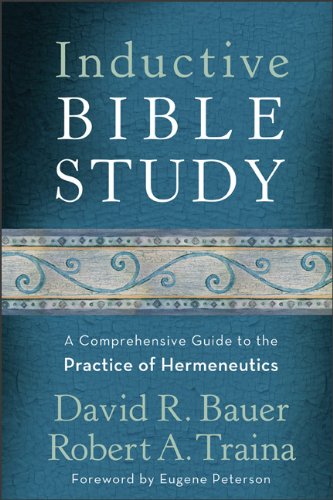 Yesterday I received, from Baker, a copy of David R. Bauer and Robert A. Traina’s Inductive Bible Study: A Comprehensive Guide to the Practice of Hermeneutics (2011). This book, essentially, follows closely the highly-acclaimed and time-tested “Traina” approach in the book Methodical Bible Study which was first published in 1952. It had never seen a significant revision, and yet it trained up a whole generation of scholars.
Yesterday I received, from Baker, a copy of David R. Bauer and Robert A. Traina’s Inductive Bible Study: A Comprehensive Guide to the Practice of Hermeneutics (2011). This book, essentially, follows closely the highly-acclaimed and time-tested “Traina” approach in the book Methodical Bible Study which was first published in 1952. It had never seen a significant revision, and yet it trained up a whole generation of scholars.
This new work, with Bauer (Asbury Seminary) as a co-author, is close to twice the length and works out the inductive method of Traina in a more comprehensive form, with a special focus on the logic and philosophy of induction, as well as interactions with academic scholarship on hermeneutics. I know that this will be a main textbook for Asbury Seminary and I was privileged to see early copies of this book to consult in preparation for courses I will be teaching for Asbury’s online campus.
The first 70 pages or so present the “theoretical foundations” of the inductive approach. Obviously, the whole point is to argue for a method focused on moving from evidence to conclusions, rather than bringing an agenda to the text by working from a deductive or presuppositional system. I also like the focus on the spirit of the inductive approach, where we come to the text accepting whatever we find – a spirit of “radical openness” (p. 18). So, “The inductively minded person welcomes discussion and even challenges; this eagerness is based on the desire to hear whatever the text has to say, whether one agrees or disagrees” (p. 19).
I am glad, also, that Bauer and Traina make it a point to note that we all have presuppositions. The key is to understand them and be open to being challenged in them.
I also appreciate the “transjective” perspective of IBS. The process of reading is neither completely “objective” or purely “subjective, but involves a “dynamic combination of objective and subjective dimensions” (28). Bauer and Traina interact here with the advantages of thinking in terms of “critical realism.”
If you know the IBS method, you know that the remainder of the book deals with the stages of observation, interpretation, and application (or evaluation). I will not take the time to explain these – you could probably figure out where the authors are going with this! Nevertheless, I appreciated the book foreword by Eugene Peterson, a long-ago student of Traina, who found this simple method to be revolutionary in his approach to Scripture.
I came in first contact with IBS after my PhD, while teaching at Ashland Theological Seminary. We used a modified approach of IBS built on Traina’s foundation, and I really appreciated it as a simple approach. Rather than spending hours and hours in “secondary” literature, students were reading, re-reading, and re-reading the Biblical text, making dozens and dozens of observations on just one chapter (especially in concert with previous and subsequent chapters).
If I were to teach a basic hermeneutics class, this would certainly be required reading. It has the utility of a straightforward method, and the sophistication of an approach that has now been worked out cogently in logic and philosophy.
My only wish was that it came with a workbook and perhaps some “cheat sheets” for making observations.











